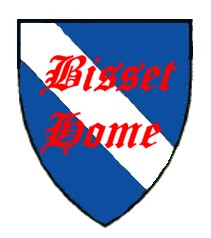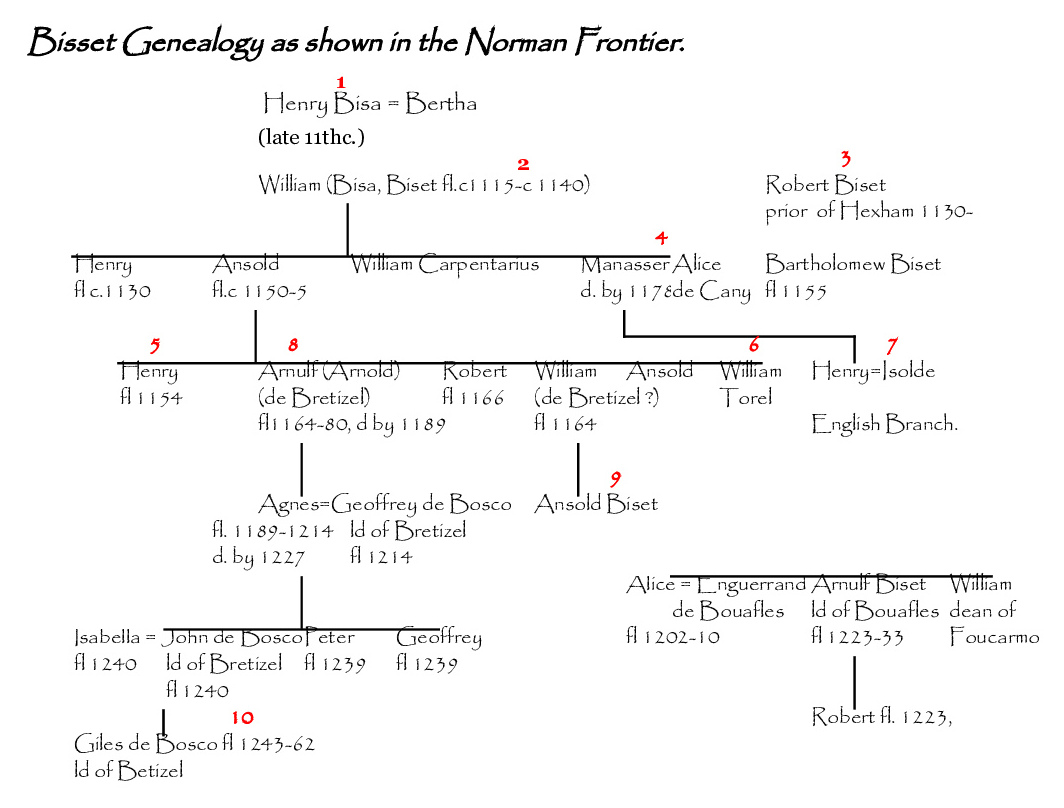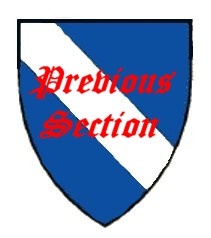
Appendix VII:
Bisset Genealogies

 |
Appendix VII:
|

|
The relationships between these 40+ individuals can be seen in a family tree diagram in figure 4.

Download as figure_4.pdf or a GEDCOM file figure_4.ged
Sources (general):
English 1979, 62, 146; Archives Departmentales de la Seine-Maritime (Rouen)
[ADSM] 1 H1, nos. 1,5; Archives Departmentales de l’Oise (Beauvais) [ADOI]
H 4653; “Ctl Lannoy”, Geoffrey de Bosco, and their descendants ADSM,
1 H 28, 1 H 32;
Bibliotheque Municipale de Rouen (Seine- Maritime) [BMRO] V 13, fols. 102r-104,
116r; Semichon 1862, I, 324-5; above.pp. 284-5. 426-7 Geoffrey was a brother
of Renaud de Bosco:see App.1, no.5 (Baudemont) RHF, xxiii, 689.
Bouafles: BMRO, y 13, fols. 118r-119r; Bauduin 2000, 157. Boufles (cant, Aumale,
cne.Vieux-Rouen). Cf. Ctl. Selincourt, nos xcii, xcv.
(1) ADSM, 1 H 1, no 1; Semichon
(1862) I, 391-3 at 393.
(2) Ch. St Martin-des-Champs,
I no. 147 “Ctl Lannoy”no 11; BMRO, y 13, fol. 811.
(3) John of Hexham, in Symeon
of Durham, Opera, ii, 284, 311; Heads of Religious Houses, 166.
(4) BMRO, y 13, fols. 84v-85r,
suggests that this Manasser was the royal steward who married Alice de Cany
(Acts de Henri ii, intro. Vol., Ch. Jumieges, ii, no. lxx, lxxi);
Ch Longueville, nos. xxxiii-xxxiv; Sanders 1960 5-6. He was probably older than
William Carpentarius (for whom, see BMRO, y 13, fol 81r)
(5) “Ctl Lannoy” no
xx; Regesta, iii, no 584.
(6) ADSM, 8 H 269; act of William
Torel (mid-late twelfth century) witnessed by “Hernaldo Biset et Will’mo
et Ansoldo fratribus meis. The wording is ambiguous, but in any case Ansold
here suggests kinship with the Bisets and an Ansold Biset appears in 1179 (Ctl
Selincourt, no ciii).
(7) CRR, I, 214. Monasticon, v
634, makes Henry’s first wife Aubreia, daughter of Richard, constable
of Chester.
(8) Ctl Selincourt, no. civ: William
de Bretesel, younger brother of Ernoldus de Bretesel, custos et ballivus of
his brother’s fief at Cuivertieres near Aumale. Bretizel, Somme, cant
Hornoy-le- Bourg, cne. Ste-Germain-sur-Bresle.
(9) Ansold whose exact kinship
to the main Biset line has not been identified, acquired Geoffrey de Bosco’s
lands in England after 1204: Rot. Ob Fin., 335-6; CRR, iv, 140,161 (cf. RN,
140; p.r. 8 John. 53); v, 19, 282; vii,53; OBL, Ms. Browne-Willis 89, fol. 126v
and Ms Dugdale 39, fols 71v 72v,
(10) In 1266 and 1272 John de
Bosco, perhaps Giles son was lord of Bretizel (ADSM, I h 12).
Dr. Robert Thoroton, 1623-1678. A doctor of medicine, magistrate and antiquary, he belonged to an old Nottinghamshire family who had been landowners from as early as the middle of the 13th century and who took their name from the village of Thoroton near Newark. He lived in the village of Car Colston the ancestral home of his grandparents where he practised as a physician, his duties as a magistrate, and researching his hobby of genealogy.
He meet Mr Dugdale, later Sir Richard Dugdale, Norroy King of Arms, and a Mr. Pigot who where researching a book on the history of Nottinghamshire which had been started by Gilbert Bohun, Thoroton’s father-in-law. Somehow Dugdale, who must have been persuaded by Thoroton’s scholarship, arranged for Thoroton to take over the work and finish it - a task which was to take him the next ten years. In 1677 he produced the folio dedicated to Gilbert Sheldon, Archbishop of Canterbury and known as “Thoroton’s Nottinghamshire". During the Commonwealth Sheldon has stayed in the adjourning parish of East Bridgeford and was well known to Thoroton.
The purpose of the book was to record the descendants of all the lands in each parish during the period from the Domesday Book to the present (1677) nearly 600 years and to that extent the book is chiefly genealogical. Quite where he found his source material is not clear; we know that Thoroton took his genealogy for the Bissets from charter details in the Thurgarton Cartulary (see "Thurgarton Cartulary" by Dr Trevor Foulds and "Thoroton’s Nottinghamshire" by Dr Thoroton).
Thoroton as an antiquarian could hardly have been unaware of the Bisset connection to his part of Nottinghamshire. The key villages run in a line starting with East Bridgeford, temporarily granted by King Henry II to Walter Bisset, is next to Car Colston, Thoroton’s home which is next to Thoroton his family’s ancient base and a few miles from Allington the manor which Manasser Bisset subinfeued to his brother William Bisset, the Carpenter. Only 10 miles separate all these places.
The following are two extracts from his book relevant to the Bissets.
Confirmation that William Carpenter was married to Susanna and they had a son Henry who was married to Albreda.
In a great book in the Duchy Office mention is made of Ranulf Earl of Chester giving Ludham [Lowdham] and Bridgeford to Henry de Lacy in Fee, but the next owners are I (Thoroton) find the family of Bisset.
William the Carpenter by the consent of Henry Biset his son and of Manasser
Biset his own brother and of Ernulphus Biset his nephew, gave his mill on Doverbek
called Clive-Milne to the Priory of Thurgarton for the souls of William Biset
his father, and Hawise his mother and Sussana his wife, and Henry Biset and
Ausolfus his brothers and Henry his nephew and all his ancestors so that the
said mill should be towards the building of the new church and when that should
be finished to be expended amongst the Friars, reserving to himself and his
heirs the multure of the corn of his demesne, when he would grind there. With
this he gave himself living if he pleased; or if he died in England there to
be buried.
Henry Biset son of William Carpenter, confirmed his fathers gift of that mill,
which with a bovat of land in Ludham and a Toft, lying by the said Clive-Milne,
likewise gave to the Priory, the passage of Briggford, with a toft belonging
to it, (which is now known by the name of Botemans Leys, and still belongs to
the ferry) with William the Miller, for the souls of his said father and of
his mother and of Albreda his wife reserving for himself and his heirs and his
servants, free fishing.
This important extract from the Thurgarton Cartulary by Thoroton sets out without argument the early genealogy of the Bissets in England. It confirms that William Bisset married to Hawise had four sons William, Manasser, Henry and Asoldus.
The fact that William is named first is simply that it he was making the gift and does in no way signify that he was necessarily the oldest son. Likewise Manasser is probably named second because the gift would have needed his approval as the hereditary lord of East Bridgeford (see above)
Ernulfus a nephew is taken as being the son of Asoldus or Henry but on balance I think it must be the former on the basis of naming patterns. We also find Henry named as Henry his nephew, who must be Manasser’s son because his own son Henry is named as such and adds his own gift which could have been done at the time or after his father’s death which would make more sense as he would be reaffirming his father’s gift and adding to it a trick I feel sure the Cannons were not going to let slip through.
The abbot of Rochester, 17.H. 3 [1233] claimed against Albreda de Bassingbourn eight carucats and two bovats of land with the appurtenances in Bridgeford, whereof every carucats contained eight bovats of land measured whereof Turstan his predecessor Abbot of Rochester, in the time of King Henry the second was seized in right of his said church. Albreda came and answered that neither she nor her ancestors ever defended this manor but by four carucats as in tallage, aids, carucats and services and called to warrant Margery, Ella and Isabella the daughters and heirs of John Bisset. Margery was then of full age, Isabella and Ella under age and in the custody of John de Plesseto: they were then summoned in the county of Southampton.
Warin de Bassingbourn paid two marks for one knights Fee in the time of Henry the Third. Albreda de Bassingbourn held a knights Fee by reason of her custody of the land and heir of John Bisset, granted by the king. Albreda had issue, Constancia and she Isabel and Agnes. Isabel was mother of Thomas de Multon of Kirketon and Agnes Phillip de Caltoft between whom in 9.E.3 [1246] the land was divided…..
Confirmation that Albreda only held East Bridgeford under royal appointment not by right of inheritance while she had custody of John Bisett, son of John and Alice Bisset. [This rather knocks a hole in the case for the Grant/ Walter Bisset emigration to Scotland as the date of the court case 1233 was a decade before the Bisset expulsion (see below) and a generation before William le Grant appears on the stage. And at the time that Walter Bisset was given the manor of Lowdham by the king (“until such time as he regained his lands in Scotland”)] the Bisset holdings had been divided between Thomas Moulton and Phillip Caltoft.
It is not clear but the assumption must be that the young John Bisset the last
male heir of the Manasser Estate had died and the lands went as dower with his
three sisters, Margery, Ella and Isabel. We know that the Athelington manor
in Lincolnshire went on a further generation with the next Albreda and William
le Grant so somehow the East Bridgeford manor was split between the granddaughters
of Albreda de Bassingbourn whose respective husband held it in life rent through
them. Technically this manor should have reverted back to Manasser’s estate
but possibly this agreement had been changed in previous generations and the
paper work has not come to light.
One confusion in the previous paragraph is that he states that Albreda and Warin
had one daughter Constancia, who is given as the mother of John de Multon no
mention is made of her husband, John’s father nor is he shown on the tree.
Thoroton makes no mention of the second daughter Albreda in his text above but
does show her in his tree below, why is not clear. Once again I suspect it is
the surfeit of Albredas but she is necessary to make the later Bisset line work
and I am more than satisfied that she is correct in place and time.
Where I beg to differ is where he shows John Bisset as son of Henry son of
William the Carpenter where I show John as son of Henry who was Manasser’s
son. I think what has happened is that in finding reference to the court case
and seeing the three heiresses daughters of John, Thoroton assumed that they
were from the Carpenter line and ignored the possibility that they were from
Manasser’s line. He was after all writing about Nottinghamshire not Kidderminster
or Hampshire and may well have been ignorant
of this situation.
The Thoroton Genealogy is as we can see based on details taken from the Thurgarton Cartulary plus information he has collected separately. East Bridgeford is an adjourning parish to Car Colston Thoroton’s own and one he would have been more familiar with than many of the others he wrote about. As a physician he may well have had patients there but as a member of an old Nottinghamshire family he would clearly have had entre to houses of the gentry and had no difficulty in reading any relevant manuscripts so we should put a lot of credence in this section of his book.
 |
Appendix VII:
|

|